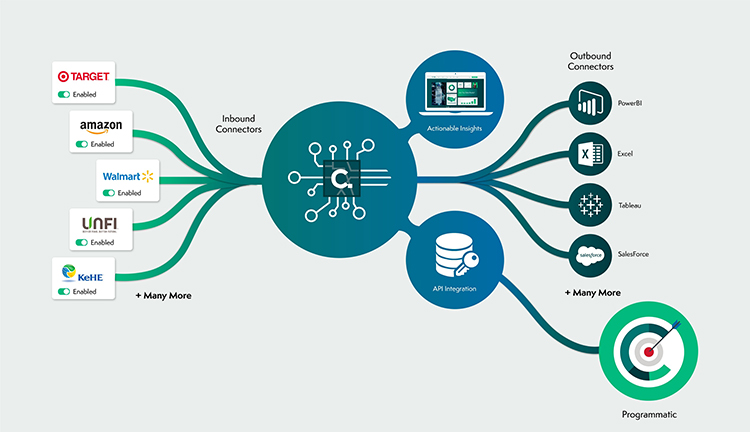At the beginning of the pandemic, restaurants were hit hard. Fine dining sales dropped by more than 90%, casual dining was down 75%, and fast casual decreased by 65%. Nearly two years later, the restaurant industry is still reeling. Most restaurants experienced huge financial losses, and many couldn’t survive. Our industry continues to deal with supply chain disruptions, rising prices, skyrocketing rent, labor shortages and other major challenges. To make matters worse, new COVID variants and surging cases has consumers on their couches watching Netflix and avoiding dining out.
Back in March 2020, delivery orders surged by 67%, and now 60% of American consumers order takeout or delivery at least once a week. Online ordering is growing 300% faster than in-house dining. And operators are discovering a colossal opportunity: Ghost kitchens.
Ghost kitchens allow operators to utilize commercial kitchens without the overhead (and expense) of a full restaurant space and staff. They focus solely on prepping and cooking “to go” orders, and don’t have the option of onsite dining.
While the business model may have shifted, ghost kitchens still need to prioritize food safety and quality, just as traditional restaurant kitchens do. As such, they should:
- Embrace digital tools. Tech tools make food safety and quality assurance much easier to manage. Use digital tools to elevate food safety checklists and audits, track ingredient lists, manage allergen information, spot trends, etc. These solutions can help staff manage food safety processes, quickly, easily, efficiently and accurately.
- Use sensors. Install digital sensors to check equipment. For instance, these tools can alert the team if a refrigerator or freezer door is accidentally left open, or if temperatures drop below a certain level. Digital thermometers are also essential to check food temps and to ensure foods are cooked properly.
- Use tech tools for ongoing training. All workers must be trained in food safety, not just upon hiring, but throughout their tenure. Use tech tools to provide regular training and safety reminders. Send small “chunks” of information right to employees’ phones and provide online resources so they have valuable information right at their fingertips. Communicate regularly with employees, sending updates on COVID protocols and other important safety information.
- Be transparent. Food safety practices used to happen “behind the scenes.” Restaurant guests just assumed that employees were taking proper safety precautions. Today, though, everyone’s demanding safer practices, and they want to see staff wearing masks, more frequent sanitation of high touch surfaces, proper social distancing, etc. Since ghost kitchens are a virtual business, you’ll have to proactively spotlight the safety and quality protocols you follow to reassure customers (and prospects) that you take safety very seriously.
- Use social media to spotlight your safe practices. Traditional restaurants display health inspection letter grades and reports in their dining areas or storefront windows. Since ghost kitchens don’t have storefronts or dining areas, you’ll need to find new ways to spotlight your commitment to safety. Post information on your website and social media platforms about your meticulous attention to safety and quality to make customers feel safe ordering from you.
- Audit differently. Pre-COVID, restaurants and other commercial kitchens had third-party auditors come onsite occasionally to inspect their facilities. Now, food businesses—including ghost kitchens—must audit differently, especially when travel restrictions and other COVID-related disruptions make in-person auditing unfeasible. Use a combination of regular self-assessments, remote auditing, and onsite inspections (when possible) to ensure safety protocols are being followed, the facilities are spotless, equipment is working properly, etc. Previously, in-person audits were often viewed as punitive, with the Big, Bad Auditor coming onsite to point out a company’s mistakes. Now, teams are more engaged and invested in the process, making these inspections more collaborative and cooperative. Also, operators are conducting more frequent remote audits and self-inspections, rather than annual or bi-annual onsite audits, which is a great way to identify (and fix) infractions before they become liabilities.
- Prioritize food safety. Even though your business model may have changed from a traditional restaurant to a ghost kitchen, your focus on food safety must remain top-of-mind. Follow food safety protocols: Cook to proper temps, store foods properly, don’t cross-contaminate, accommodate food allergies, etc. In addition, be sure everyone on your team follows COVID protocols: Frequent sanitation of high-touch areas, frequent hand washing, social distancing, masking and not working when ill.
- Only work with vendors that prioritize food safety. Be aware of your vendors’ food safety policies. Only work with suppliers that adhere to the strictest safety and quality standards, and make sure that they’re properly certified. New software solutions allow you to easily manage and track supplier certifications.
- Accommodate food-allergic guests. Train your staff about food allergies. Have a knowledgeable manager carefully oversee meal prep (and answer questions) for food-allergic customers. Designate an allergy-friendly prep area where foods can be prepared without contamination risk. Use clean and sanitized utensils to prepare allergy-friendly foods. Mark food-allergic guests’ meals with a frill pick or special colored container. Put allergy-friendly meals in separate containers for delivery so there’s no risk of cross-contamination.
- Deliver foods safely. Delivery-only concepts must ensure that foods are kept safe from their kitchen to their customers’ homes. Your drivers should have equipment to keep foods at proper temperatures—hot foods hot, cold foods cold—during delivery. Drivers should also sanitize their hands frequently, including after they touch doorknobs, doorbells, money, pens, etc.
Ghost kitchens are an exciting new chapter for our industry. It has been wonderful to see savvy operators pivot to this new business model to accommodate increased consumer demand for “to go” meal options. While ghost kitchens operate without the overhead and infrastructure of traditional restaurants, they still must prioritize food safety every day, for every shift and every meal.























